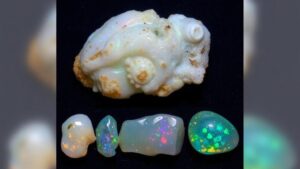Fossilized Wings: Discovering Prehistoric Insects in Stone and Amber
Fossilized Wings: Discovering Prehistoric Insects in Stone and Amber
The fascination with fossilized wings of prehistoric insects draws countless rockhounds and mineral collectors into the world of paleontology. These exquisite remnants provide a tangible connection to Earths distant past, offering insights into ancient ecosystems and the evolution of life. In this article, we delve into the diverse types of fossilized wings, the significance of stone and amber specimens, and practical tips for collectors eager to enhance their collections.
The Fascinating World of Fossilized Insects
Insects comprise a vast and diverse group of organisms. It is estimated that approximately 1 million species of insects have been described, with many more yet to be classified. Fossilized wings have been discovered in various geological formations and can range from 400 million to over 100 million years old, providing a timeline of insect evolution. Most notably, the study of these fossils helps researchers understand not only the insects themselves but also the ancient environments in which they thrived.
Types of Fossilized Wings
Fossilized wings can primarily be found in two formats: those encased in stone and those preserved in amber. Each medium presents unique characteristics and opportunities for study.
- Stone Fossils: These are typically found in sedimentary rock formations. Fossilized wings in stone can be exceptionally detailed and often include impressions that allow scientists to study the anatomical features of wings.
- Amber Fossils: Amber preservation is particularly notable for its ability to trap organisms in a state of remarkable detail. Fossils in amber can include not only complete wings but also entire insects, often retaining their original coloration and even soft tissue, allowing for incredibly accurate studies.
Significance of Fossilized Wings
The study of fossilized insect wings provides valuable insights into various fields of research, including paleoclimatology and evolutionary biology. For example:
- Fossils from the Cretaceous period offer indications of ancient climates through the presence of species that thrive in specific environments. This allows scientists to reconstruct past ecosystems accurately.
- Fossilized wings from different periods can showcase evolutionary adaptations. An example is the comparison of the delicate wings of dragonflies, which have been found dating back to the Carboniferous period, indicating the development of flight mechanisms over millions of years.
Collecting Fossilized Wings: Tips for Enthusiasts
For rockhounds and mineral collectors, gathering fossilized wings can be both an exhilarating and educational endeavor. Below are some practical tips to consider:
- Research Local Geology: Familiarize yourself with the local geology and sedimentary formations known for fossil preservation. Locations such as the Green River Formation in Wyoming or amber deposits in the Dominican Republic offer promising opportunities for finding exceptional fossils.
- Join Local Clubs: Connect with paleontological societies or rockhound groups in your area. Engaging with other collectors can provide valuable resources, guidance, and field trip opportunities.
- Invest in Quality Tools: Use tools specifically designed for fossil collecting, such as hammer and chisel sets, brushes for cleaning, and specimen trays for transport. Protecting delicate fossils during extraction is crucial for preserving their detail.
- Maintain Documentation: Document the location, geological context, and any pertinent details of your finds. This practice not only enhances the value of your collection but also contributes to the body of scientific knowledge.
Real-World Applications of Fossil Studies
The study of fossilized wings transcends mere collection; it has practical applications in various industries. For example:
- Agriculture: Understanding the evolution of insects can help in pest management strategies by predicting invasive species and their ecological roles.
- Climate Science: Paleoclimatologists use fossil records to model climate changes and their impacts on biodiversity, providing a clearer picture of how current ecosystems might respond to ongoing environmental shifts.
Conclusion: The Journey of Discovery
Fossilized wings open a fascinating window into the prehistoric world of insects, attracting collectors and researchers alike. not only embody the beauty and complexity of nature but also serve as crucial indicators of the evolutionary journey of life on Earth. For rockhounds and mineral collectors, the pursuit of these fossils is not just about building a collection; it is also an exploration of our planets history, an appreciation of biodiversity, and a commitment to conserving our natural heritage.
By actively participating in the collection and study of fossilized wings, enthusiasts contribute meaningfully to both scientific understanding and the appreciation of Earths ancient past. Happy hunting!


